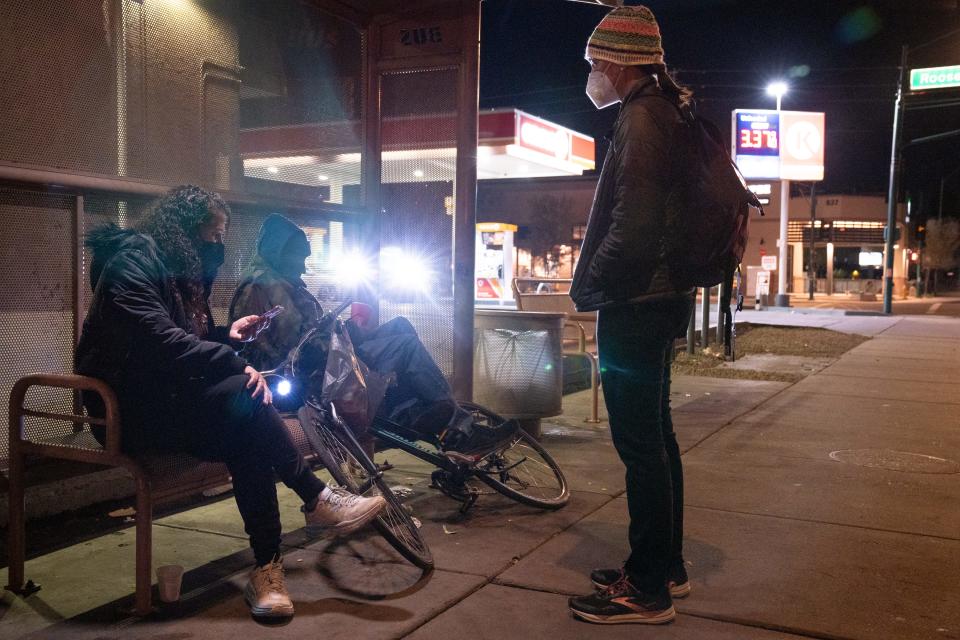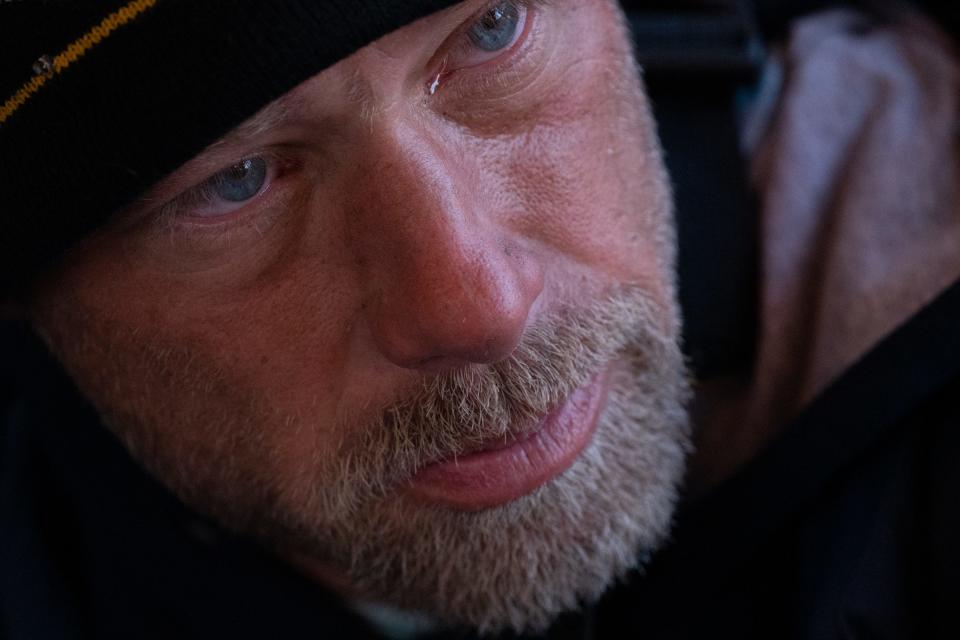'We're not lazy': Volunteers hear from people experiencing homelessness during annual count in Maricopa County
Three years ago, Darian Perez had a job as a machinist and an apartment in Phoenix.
Then he had a motorcycle accident, began to have seizures, and he became caught in a painfully common cycle: Extra costs meant he had trouble paying rent. Once he became homeless, it became increasingly difficult to be presentable for work.
“We’re not lazy,” says Perez, of what he wishes people understood about people experiencing homelessness. “We just fall into this vicious circle.”
Last night, Perez slept outside, in the parking lot of a church in downtown Phoenix.
And he’s not alone. Perez is one of thousands of people without homes who slept outside in Maricopa County last night. They huddled with suitcases carrying their mystery novels and medications against the stone walls of churches, pinned tarps up to lesser-trafficked downtown streets and covered up with long blankets in an effort to catch some rest.
Tuesday, some of them were counted as part of an informal census of people living on the street used by the federal government to apportion aid for homeless people.
The annual Point-in-Time Count is required by the U.S. Department of Housing and Urban Development and is considered an important, but imperfect, tool for localities to evaluate the extent of the homeless need in their area.
Maricopa Association of Governments, the organization that runs the annual count, sent out staff and volunteers to walk the streets, alleyways and underpasses and talk to people.
The group is aiming to release its results in February. Experts predict the COVID-19 pandemic has led to a spike in homelessness over the past two years. Even before the pandemic, homelessness had increased by 32% between 2017 and 2020.
Tuesday's count was the first countywide census of people experiencing homelessness since January 2020. Nationally, about 60% of homelessness service providers opted out of the 2021 count.
"The majority of nonprofit providers, outreach teams and municipal coordinators just did not feel comfortable ... due to the fact that of course COVID-19 is very dangerous and the Point-in-Time Count takes over 1,000 volunteers," MAG Human Services Planner Sarah Kent said last year.
In January 2020, the last MAG Point-in-Time Count, at least 7,419 people were experiencing homelessness. Experts say this is likely a significant undercount because it's difficult to locate all people experiencing homelessness on a single day.
This year, volunteers were trained on COVID-19 protocols to keep both themselves and unhoused people safe, including how to keep social distance when interviewing people, prohibiting handshakes and keeping teams small.
But a mix of concern over COVID-19 and people getting sick significantly decreased the number of volunteers: More than 400 were out on Tuesday.
“We don’t anticipate a reduction in homeless numbers, but we anticipate there will be a reduction in volunteers,” said Nicky Stevens, regional homelessness program manager for the Maricopa Association of Governments.
A right to housing
The sky was pitch black when Nicky Stevens and colleague Kelli Williams from the Maricopa Association of Governments headed out about 5:30 a.m. to find people experiencing homelessness.
Their zone included parts of downtown Phoenix, where high-rise luxury apartments that mark the city’s growing housing affordability crisis abut public parks and offices where people experiencing homelessness are seeking shelter for the night.
Both Stevens and Williams came to the work with a sense of mission. Stevens said she felt driven by the idea that people had a right to a home and, when she started working around housing, it felt right.
Williams said service work was a large part of her Methodist religious upbringing.
“Our country has the resources to take care of everybody,” Williams said. “And we choose not to, and that is very bothersome to me.”

When Stevens and Williams asked people if they could interview them, they also offered face masks, hand sanitizer and a list of resources. At one point, Williams gave a woman her gloves.
They were both often sympathetic, even as the count had them asking direct questions about mental illness and domestic violence.
“I’m sorry, I know this is difficult,” Stevens said to one person.
The main lesson they passed to volunteers was to treat the people experiencing homelessness they talk to with respect.
“I encourage people to practice,” Stevens said. “It’s difficult to have these conversations, but being authentic and genuine and treating people with dignity.”
A need for support
In 2020, for the first time in recent history, more than half of the people counted in the count were not staying inside a shelter and instead slept on the streets, in desert washes, in vehicles or another place not meant for habitation.
This is because metro Phoenix has a severe shortage of emergency shelters. The county has fewer than 2,000 emergency shelter beds, and they are full nearly every night.
Many have also had negative experiences in shelters or treatment programs.

COVID-19 has also only made it more difficult to be homeless, said Eric Lopez Jr., who spent the night wrapped in a blanket in a public park near Phoenix’s central library.
“They’re shutting down the bathrooms. They’re shutting down the waters,” he said, describing people using the bathroom outside. “That’s a problem.”
Some elements of care and community were clear on Tuesday morning: Perez chose not to go to a shelter so he wouldn’t be separated from his companion. Two people huddled together under a blanket at a downtown bus stop. Multiple people came by on bikes and greeted Lopez as he sat huddled against a pillar.
But many also carried pain: One person described multiple cases of sexual assault and violence such as stabbing. Perez said he was recently robbed, a theft that took his companion’s medication.
What some of the people outside on Tuesday said they wanted was a recognition of their humanity and the right to take up space.
“We’re human beings,” Lopez said. “We should be treated as such.”
Reach the reporter at ykunichoff@arizonarepublic.com and follow her on Twitter @yanazure.
Reach the reporter at jessica.boehm@gannett.com or 480-694-1823. Follow her on Twitter @jboehm_NEWS.
Coverage of housing insecurity on azcentral.com and in The Arizona Republic is supported by a grant from the Arizona Community Foundation.
Support local journalism. Subscribe to azcentral.com today.
This article originally appeared on Arizona Republic: Phoenix homelessness: Annual count returns after COVID-19 interruption

